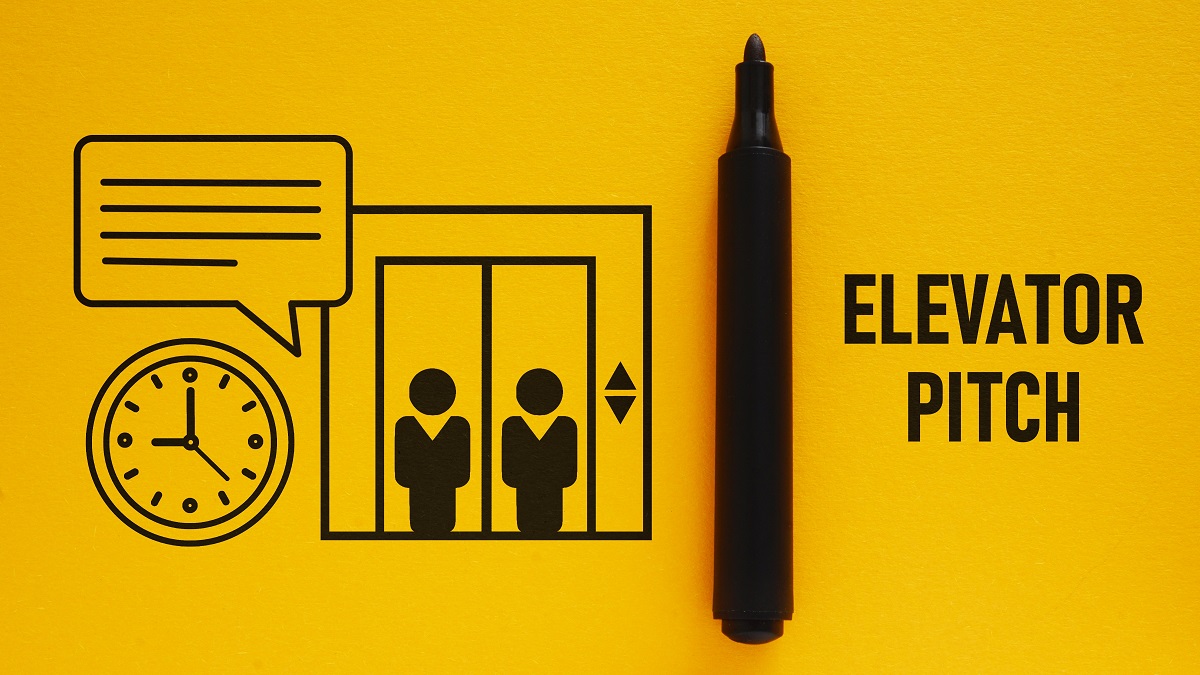An elevator speech is a brief pitch about yourself that lasts about as long as an elevator ride. In it, you introduce yourself, mention an important thing or two about yourself or your idea, and make a connection with someone. Its purpose is a call to action to set up a further discussion.
Ever chatted with someone on an elevator? If so, it would have been a brief conversation. That short time as the elevator goes from floor to floor is the inspiration for the elevator speech that allows you to introduce yourself and give a reason to want to know more about you.
What Is An Elevator Speech?
An elevator speech is a professional networking tool essential to making a good first impression.
These brief speeches can be used in any industry, for any product or service, or to sell yourself and what you have to offer.
There are several scenarios when an effective elevator pitch can be an important tool. A few of the most common are,
- Networking events or career fairs
- During a job search
- On platforms like Linkedin as a digital business card
These brief speeches are also used by,
- Salespeople trying to gain an audience with a decision maker
- Entrepreneurs who need investors
- Startups that need capital
- Nonprofits looking for donors
- Recruiters looking to entice professionals
- Job seekers as a personal sales pitch to hiring managers
An elevator speech is a way of introducing yourself or your company. It often answers the dreaded interview question, “Can you tell me about yourself?”
A good elevator pitch is quick and provides specific information that piques the interest of the person you’re speaking to. The goal is generally to gain the opportunity for a more extended conversation. You can achieve this by giving select, relevant details that justify your request for more time.
Of course, an elevator speech doesn’t need to be given on an elevator. It just needs to be something you could effectively say during the time it takes for an elevator ride. Think 30-60 seconds max.

What Should I Say In Your Elevator Speech?
When crafting the perfect elevator pitch, be strategic about the information you use. Remember, your goal is for the person you’re speaking to want to hear more.
This means what you tell them should be exciting and vital and demonstrate how hearing more from you will benefit them.
At its most basic, an elevator pitch should include the following:
- Who you are
- What you do
- What you offer
All of which should explain the value proposition of you or your company.
You might highlight key information like,
- Years of experience
- Referral details if someone has referred you
- Social media presence
What Are The 4 Main Components Of Elevator Pitches?
Crafting an elevator speech can be more complicated than one might think. Delivering the right information in a limited time takes thought and planning.
As you’re determining what should be said, make sure you include the following 4 components:
- Your product. You may be offering a tangible product, a service, or you.
- The problem you are attempting to solve. Identify ahead of time something that is a pain point and can be done more efficiently or more cost-effectively. If you are the product, know where you could fit within the organization and why you belong there.
- Your proposed solution. How does your product, service, or you solve the issue you’ve identified?
- The benefit of your solution. Time to shine! You should be able to articulate “what’s in it for them.” Explaining the benefits of your unique selling proposition and solution should be simple, clear, and concise. And make them want to know more.
You need to accomplish all of this in 30 seconds.
What Are The 5 Common Mistakes Of Elevator Speeches?
How hard can it be to sum up your background and future potential in less than a minute?
Delivering key points that are truly relevant and compelling in under 60 seconds can be very challenging, and mistakes are common.
As you prepare your speech, avoid these 5 common mistakes.
- Too much information. One of the biggest mistakes is trying to cram too much information into what should be a short speech. A laundry list of features and benefits (FAB) will cause your listener to tune out. Remember, you want them to WANT to know more, so stick with a couple of intriguing highlights that generate interest.
- Talking too long or rambling. Talking too long goes hand-in-hand with too much information. However, talking too long sometimes occurs through rambling, off-topic comments that burn through time and attention.
- Poor body language and eye contact. A big part of communication is unspoken. Your body language conveys a great deal and, when done right, can be a significant asset. You can silently communicate the message, “I’m confident, knowledgeable, and have something to offer,” while delivering your elevator speech. Or you can communicate, “I’m nervous, unsure of what I’m saying, and skeptical of my own abilities,” if you’re not careful.
- Not communicating your value proposition clearly. Effectively showing someone the value of your product (or you) means you need some understanding of what the person you are approaching considers valuable. Then using only necessary words, connect your value to their idea of value.
- You don’t have a goal. Putting time into creating an elevator speech is wasted if you don’t know your end goal. What do you want your listener to do after hearing what you say? What’s your call to action?
Goals can vary depending on who you’re speaking with, so be prepared with more than one speech or a speech that is easily adaptable according to the situation is wise.

How Do You Create An Elevator Speech Outline?
One of the best ways to create a successful elevator speech is to begin with an outline and expand from there. Many elevator pitch templates available online can help you get started.
A classic elevator speech outline contains the following:
Introduction And Information About You
The key components are,
- An interesting opening statement that gets your audience’s attention
- Your name and relevant fact (company, school, or other connection to them)
- Maintain eye contact and a smile.
What You Offer
The key components are,
- Why you wanted to speak with them, or are you happy to run into them?
- Recent problems solved or achievements similar to issues they face or otherwise pertain to them.
- Brief description or example.
Benefits Of Your Product, Service, Or You
The key components are,
- Attributes that make what you offer unique or uniquely qualified to help.
- Any additional advantages of what you represent?
How What You OfferSolves A Problem They Face
The key components are,
- Bring things full circle and show how everything you say can help them.
- Offer targeted and important specifics
- Show them there’s something in it for them.
Call To Action (Your Goal)
The key components are,
- Know what you want to achieve. Do you want a formal meeting, additional time in the current conversation, a job interview, or capital?
- Be ready to ask for it.
Once you have your outline and have filled in the blanks for your elevator speech, read through and edit.
There’s a good chance you have too much information for a 30 – 60 second speech. As you edit, consider what points are most important to convey and start weeding out extraneous information that can be discussed later.
Next, you’ll want to practice out loud and time yourself. The best elevator pitch will have a natural flow.

What Are Some Tips For Giving An Elevator Speech?
With your speech outlined, fine-tuned, and practiced, you’re ready to put it to use. There are a few things that you should keep in mind for your speech delivery, however.
- Smile, smile, smile.
- Relax. It may be an elevator speech, but it’s also a conversation. If you’re at ease, you’ll put the person you’re speaking to at ease.
- Ensure your speech answers the question, “What’s in it for me?”
- Be authentic. Don’t use jargon or an alphabet soup of acronyms.
What Is An Elevator Speech Example?
Wondering what it looks like when all the pieces come together? Take a look at the elevator speech below for an example of a short and sweet pitch.
I’m John Doe from ABC Grading Systems. The founders of my company were teachers just like you. They found the most frustrating part of their job to be, you know what I’m about to say, don’t you? (Smiles and nods at the customer) Report cards, right? It’s crucial to get it right, but so time-consuming. That’s why we created and patented the ABC Grading Wizard. What used to take nearly a week can now be done in less than an hour. Do you have some time for me to tell you more about it?

